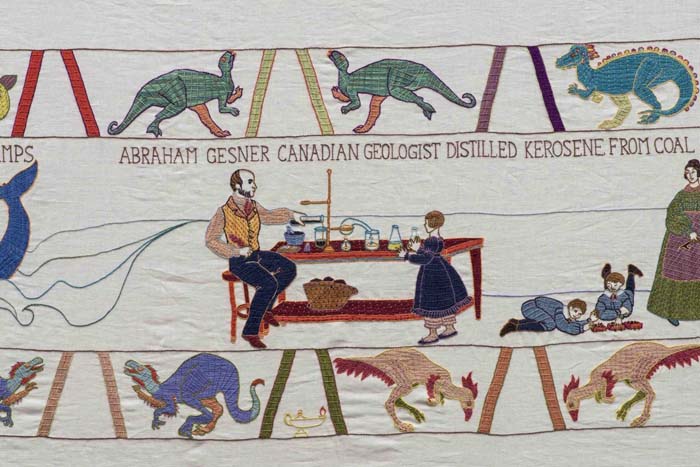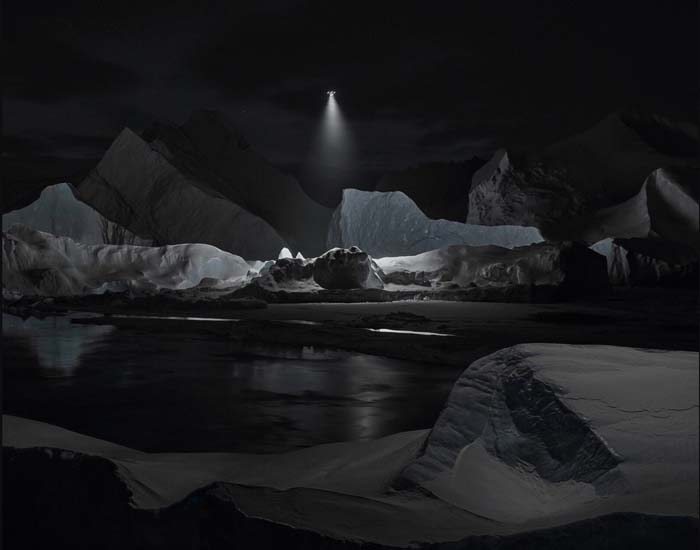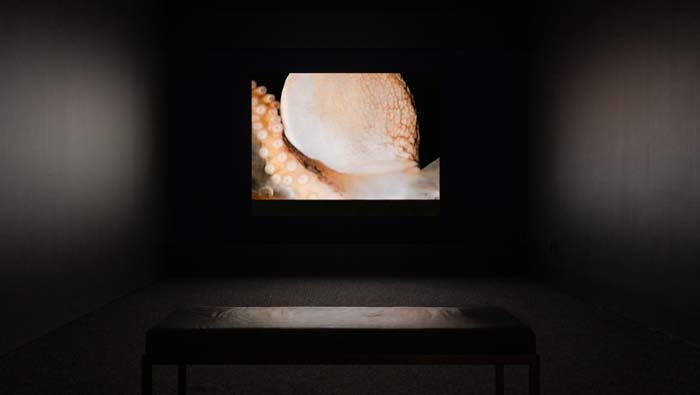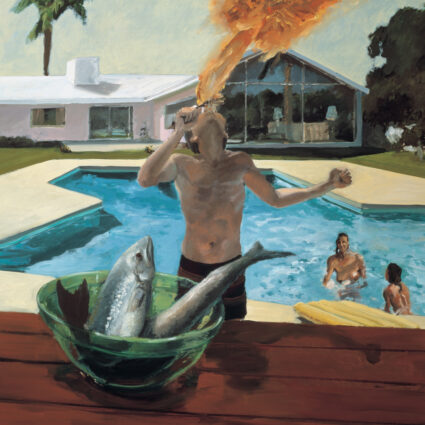If the Sky Were Orange: Art in the Time of Climate Change looks at global warming with a right brain/left brain lineup of scientists, journalists, and artists.
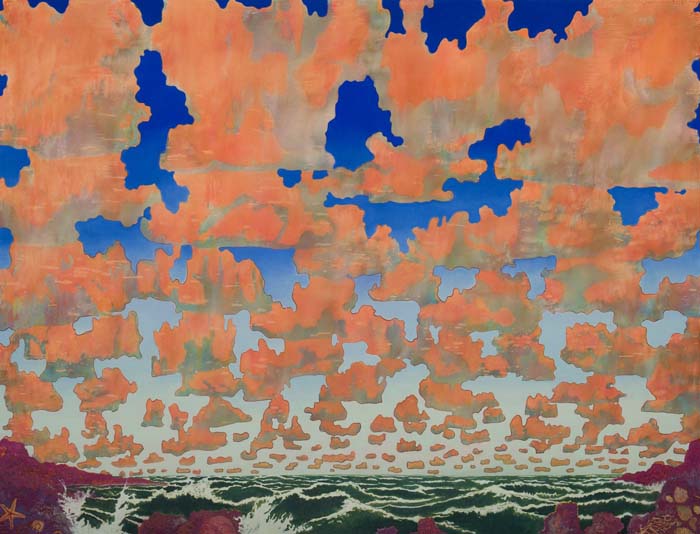
If the Sky Were Orange: Art in the Time of Climate Change
September 9, 2023–February 11, 2024
Blanton Museum of Art, University of Texas at Austin
If the Sky Were Orange: Art in the Time of Climate Change is no longer a hypothetical after the wildfires in Nova Scotia this past summer cast a tawny haze over New York City and elsewhere.
But the exhibition’s guest curator, journalist Jeff Goodell, author of the recently published The Heat Will Kill You First: Life and Death on a Scorched Planet, wasn’t trying to make a prediction. He was recalling a conversation from fifteen years earlier while sailing on a scientific vessel in the North Atlantic. Goodell writes in the show’s introductory text that he had asked a scientist onboard what it would take for people to care about rising global temperatures. The scientist replied that if the carbon dioxide accumulating in the Earth’s atmosphere were purple rather than invisible, people would care.
A large and vaguely apocalyptic painting installed at the gallery entrance seconds that notion. Aaron Morse’s Cloud World (#3) (2014), features a fiery sputter of sky over a restless ocean. Not purple, but point taken.
An exhibition about climate change in a museum in Texas seems especially opportune given the Lone Star State’s leading role in both extractive industries and renewable energy. Yet If the Sky Were Orange is not so much a political statement as it is a holistic approach.
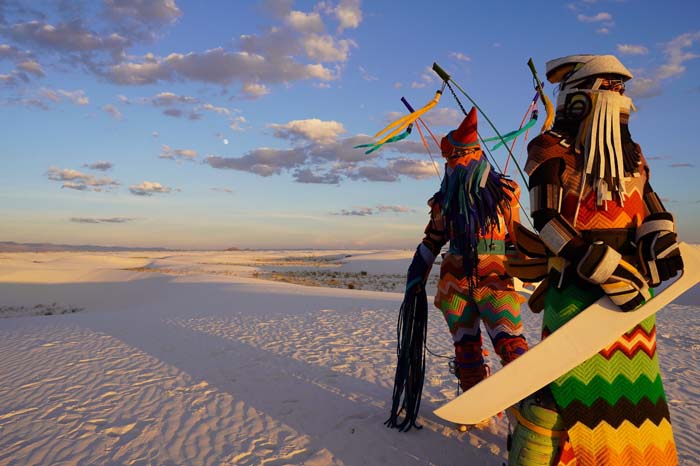
Split into two parts, the first portion of the exhibition pairs ten writers—scientists, journalists, a novelist—with ten contemporary artworks. Each writer offers their expertise, if not poetic take, in the form of a micro essay located next to the work. (These essays can also be accessed through the exhibition’s digital resource.) Without being overly didactic, each pairing encourages dialogue, albeit delicately, around such subject matter as melting ice caps, combustible trees, and climate refugees.
Writer and activist Julian Brave NoiseCat (Secwepemc/St’at’imc) analyzes Cannupa Hanska Luger’s (Mandan, Hidatsa, Arikara, Lakota) dreamlike Future Ancestral Technologies: New Myth (2021), a video of two figures in colorful crochet dress crossing a vast white desert. NoiseCat describes the man and woman as Monster Slayers, at one point noting, “Capitalism’s gas cooks on colonialism’s stove of industry, infrastructure, and ideology.”
Amitav Ghosh, author of The Great Derangement: Climate Change and the Unthinkable, writes about Sandra Sawatzky’s The Black Gold Tapestry (2008-17), calling it a “genealogy for humanity’s present predicament by placing it within history.” A segment of the hand-stitched timeline, which took nine years to make, takes up two walls of the gallery and tells an epic story of energy use throughout time.
Investigative journalist Amy Westervelt outlines a brief history of oil drilling and its legacy, starting in West Texas at the turn of last century, in relation to John Gerrard’s Western Flag (Spindletop, Texas) (2017), a computer-simulated video of a flag puffing thick black smoke against a clear bright sky on the site where the world first struck oil.
In the second part of the exhibition, Goodell presents wall text (also accessible online) for nearly sixty works pulled from the Blanton’s collection, grouping them into seven categories informed by his own twenty-year background as a journalist covering climate issues. The works in “Idealized Nature,” “The Romance of Energy,” and “The Age of Abundance” maintain a calm demeanor while those in “Power, Money, and Activism,” “Consequences,” and “The Great Rearrangement” paint a more urgent picture.
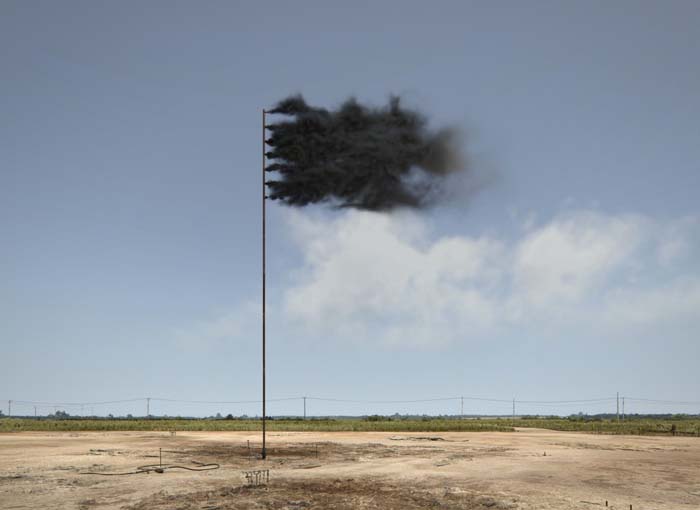
Claude Lorrain’s 400-year-old painting Pastoral Landscape (1628-1630) admires the beauty of nature while Nic Nicosia’s gale-force photograph Near (modern) Disaster #8 (1983) fears it, with three beachgoers—a father and his two children—nearly blown off a boardwalk.
Goodell ends on a curatorial positive note with the grouping “Bounty of Nature,” most notably featuring a still life painting of the same name—but it’s Julian Charrière’s haunting film Towards No Earthly Pole (2019) that gets the final word in If the Sky Were Orange.
With accompanying text by Elizabeth Kolbert, author of The Sixth Extinction: An Unnatural History, Charrière’s 104 minutes of footage, taken at night in various polar landscapes, captures mysterious shapes and movement more akin to abstract art than Antarctica. These extremely remote places are experiencing the fastest changes from rising temperatures—an alarm bell ringing in the distance. And a polarizing issue, to say the least.
On October 29, 2023, Blanton Live: Conversations For Now will host a panel on climate change and art with Jeff Goodell, Katharine Hayhoe, and Julian Brave NoiseCat, followed by a book signing.
